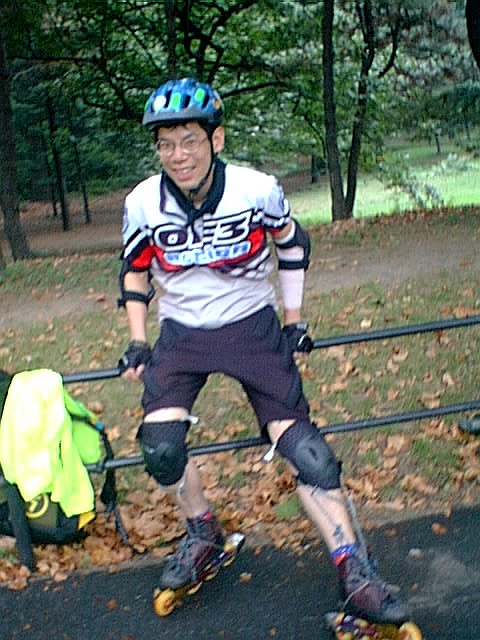
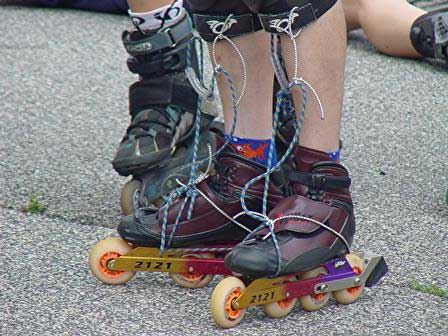
-------------------------------------------------------------------------------- Posted below, with Huyen Tran's permission, are excerpts from private e-mail I exchanged with him about his brake leverage device implementation. He skates on (very) low-profile Miller 2121 extended 4-wheel racing frames in Philadelphia, Pennsylvania, U.S.A. Uwe Brockmann -------------------------------------------------------------------------------- From: Huyen Tran To: Uwe Brockmann, uwe@pobox.com Date: 2001-05-21 Here's a brief positive initial report: I built a brake leverage device for my right brake following your instructions. I went on a city skate yesterday to test the unit, mostly on level ground. Even with the National Skate Patrol directing traffic, there were a lot of red lights where I needed to stop rapidly. The device worked very well. I could apply much more power while braking, so my stops were shorter and my shin muscles didn't get tired. Initially I had to fumble to find the handle while skating, but soon I could reach for it without looking. The two half hitches and overhand knot that I used to tie the upper elastic cord to the pull cord without ring came undone once, then the pull cord and handle drooped down and I had to stop skating to retie it. Over all, my braking and comfort have improved with one brake leverage device. When I have the second brake and leverage device, I will try some steep hills and send you a report. I will also send you further details on how I adapted your construction technique. -------------------------------------------------------------------------------- From: Huyen Tran To: Uwe Brockmann, uwe@pobox.com Date: 2001-05-22 I was afraid of drilling holes in my frames, so I tied the pull cord to the front of the frame, about 2 1/2" behind the front-most axle. This may not be possible on other boot/frame combinations or positions. My front mount on my boot is bolted to the rear-most of the two front-mounting-holes on my 2121 frame, so I have the front-most front-mounting-hole of my frame open and I was able to thread the pull cord through this hole and attach it here. This is about 3/4" behind where I would have drilled a hole, so I will lose a little leverage in comparison to drilling. But it's 7 1/2" in front of the rear boot mounting hole, so there is probably adequate leverage. The cord attachment to the frame is also 1/2" higher than it would be with drilling, I don't know if that makes a significant difference. Whether or not it's optimal, I get better, more comfortable braking when compared to braking without a brake leverage device, without holes in the frames. I don't know if a frame with extra holes changes its skating characteristics noticeably. Plus I'm not a very good driller... I wear step-in knee pads, so I attached the upper elastic cords to the lower velcro strap of the knee pad instead using 1 1/4" wide elastic Velcro. Per your suggestion, I did not use metal rings. The elastic cords shift around on the pull cord, I'm not sure if that's OK or bad yet. I have not yet decided if I should make a knot (maybe 21 The Harness Loop) on the pull cord to fix where the elastic cord attaches, or if the set-up works acceptably without any more tweaking. Any change means a lot of knot untying/tying so if it works OK I'll probably leave it alone. -------------------------------------------------------------------------------- From: Huyen Tran To: Uwe Brockmann, uwe@pobox.com Date: 2001-05-26 Here are some more construction details. I bought the pull cord from an Eastern Mountain Sports retail store. http://www.shopems.com/webstore/webstore.nsf/(prodidlu)/3MMCORD "3mm Accessory Cord, a general utility purpose cord, NOT for use in lead climbing, rappelling or supporting a climber's weight ", $0.20 per foot. Tensile strength: 594 lb. (270kg); I think this is for a static load, I'm not sure how much safety margin is needed for braking. They also sell 2mm cord which may be easier to squeeze through under the boot and tie knots with, but they didn't show the tensile strength rating. Can you measure the outer diameter of your pull cord? If it's 2mm and it has worked for you, I may prefer that. I also bought the thin elastic cord there. http://www.shopems.com/webstore/webstore.nsf/(prodidlu)/61352E "Shock Cord 3/32 Elastic shock cord for repair of shock-corded tent poles", $6.00, 3/32 in. diameter, 18 yds. total length. I'm attaching 1.jpg, 2.jpg, 3.jpg to show how I tied the pull cord to the front of my frame.
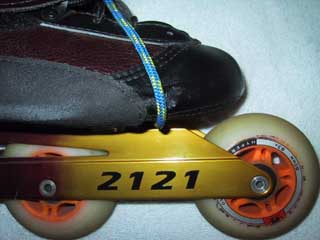
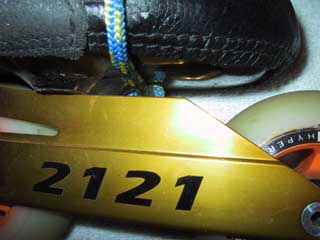
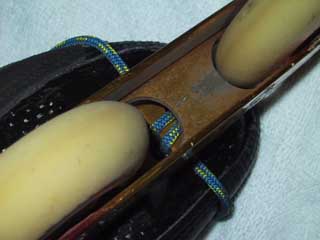
4.jpg shows a potential alternative method to attach the pull cord without drilling the frame. By looping the pull cord behind the boot and tying a knot to keep it snug, I may not need to thread it through the front-most front-mounting-hole of my frame. If this works and the pull cord looping behind the boot does not get in the way, this variation may be applicable to many more boot/frame combinations.
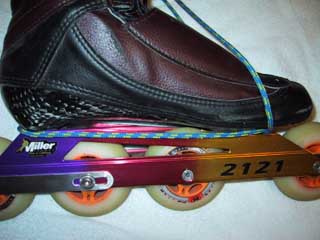
--------------------------------------------------------------------------------
From: Uwe Brockmann, uwe@pobox.com
To: Huyen Tran
Date: 2001-05-28
I have purchased both 2 mm and 3 mm accessory/utility cord in Germany
for use as the load-bearing pull cord. However, I only use the 3 mm cord
because I do not trust the 2 mm cord to be strong enough. I did not see
tensile strength ratings for either cord at the store where I bought it.
I think that 3 mm is about the optimal diameter for the pull cords.
I have bought both 2 mm and 3 mm elastic shock cord in Germany. Both
work fine for keeping the pull cord out of the way when it is not being
used. The 2 mm elastic cord has the advantage of stretching more in this
application while the 3 mm elastic cord has the advantage of being more
durable.
Since I ran out of my German elastic cord I recently purchased 7/64"
(approx. 2.8 mm) elastic shock cord from the local R.E.I. store in
Atlanta, Georgia, U.S.A.:
http://www.rei.com/cgi-bin/ncommerce3/ProductDisplay?prrfnbr=2153&prmenbr=8000
I have not used the 7/64" elastic cord yet but I expect it to work well.
Your 3/32" (approx. 2.4 mm) shock cord should also work well. R.E.I.
also sells 1/8" (approx. 3.2 mm) shock cord. That cord may be a little
bit too stiff.
Based on my experience with the 2 mm and 3 mm elastic cords I estimate
that the order of desirability for the various elastic cords, from best
to worst, is approximately as follows:
1. 3/32" (approx. 2.4 mm)
2. 7/64" (approx. 2.8 mm)
3. 2 mm
4. 3 mm
5. 1/8" (approx. 3.2 mm)
--------------------------------------------------------------------------------
From: Huyen Tran
To: Uwe Brockmann, uwe@pobox.com
Date: 2002-05-23
The brake leverage devices are great. I have not used both at the same
time yet, after engaging one brake I hesitate to engage the second brake
for fear of losing my balance, it's a mental hurdle I haven't jumped
yet. My stopping distance with one brake and leverage device is much
shorter than with one brake only, and on long downhills I alternate
which side I use.
--------------------------------------------------------------------------------
Uwe Brockmann, uwe@pobox.com, http://www.panix.com/~uwe/brakelev/